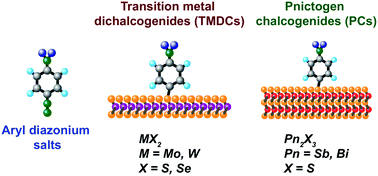Covalent chemical functionalization of semiconducting layered chalcogenide nanosheets†
Abstract
Layered chalcogenides are a diverse class of crystalline materials that consist of various covalently bound building blocks held together by van der Waals forces. Among these materials are the transition metal dichalcogenides (TMDCs) which can be exfoliated into two-dimensional (2D) nanosheets, and the pnictogen chalcogenides (PCs) which can be exfoliated into one-dimensional (1D) nanoribbons and 2D nanosheets. These materials have recently been extensively studied for their intriguing electronic, optical, and chemical properties. The chemical functionalization of 1D and 2D nanomaterials is an important enabling step for tuning their properties and forming interfaces with other materials and structures. However, broadly applicable and versatile chemical tools that can effectively functionalize a wide range of layered chalcogenide compositions without disruptive pre-treatments need further advancement. Here we show the covalent functionalization of nanosheets of the representative TMDC materials MoS2, WS2, MoSe2, and WSe2, and of the representative PC materials Sb2S3 and Bi2S3 using aryl diazonium salts. Covalent bonds are formed on the basal planes of both mechanically exfoliated and liquid phase dispersed nanosheets, and the chemical and morphological changes upon functionalization are verified using a combination of spectroscopic and microscopic techniques. This work builds on previous demonstrations of diazonium functionalization of 2D materials like MoS2, and expands it to five additional compositions. Thus, the aryl diazonium chemistry is shown to be a versatile and powerful approach to covalent functionalization of the 2D nanosheets of a diverse set of semiconducting layered chalcogenide materials.

- This article is part of the themed collection: 2D materials: molecular design and engineering perspectives


 Please wait while we load your content...
Please wait while we load your content...